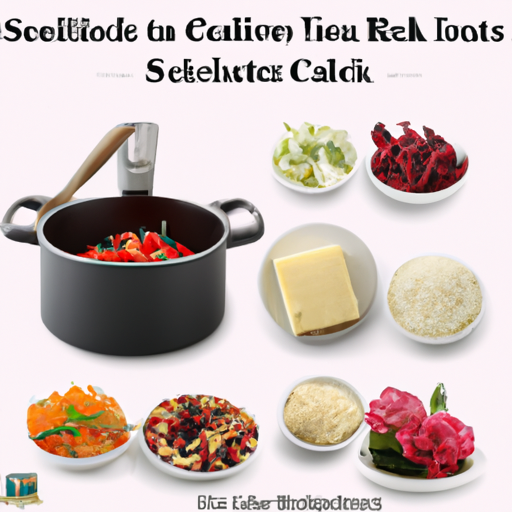In this article, you will discover a comprehensive guide on how to effectively use a cooking times calculator. Whether you’re a seasoned chef or a beginner in the kitchen, this essential tool will revolutionize the way you cook. By simply entering the type of food and its weight, the cooking times calculator will provide you with accurate timings for a perfectly cooked dish every time. Say goodbye to undercooked or overcooked meals, and say hello to culinary perfection. Let’s dive into the world of cooking precision with the ultimate cooking times calculator.

What is a Cooking Times Calculator?
A cooking times calculator is a helpful tool that assists you in determining the appropriate cooking time for various types of food. It takes into account factors such as cooking method, food type, weight, and desired doneness to provide you with an accurate estimate of how long you should cook your meal. Whether you’re using an oven, a grill, or a slow cooker, a cooking times calculator can be an invaluable resource that ensures your food is cooked to perfection every time.
Types of Cooking Times Calculators
1. Oven Cooking Times Calculator
An oven cooking times calculator is specifically designed to help you determine the cooking time for dishes prepared in an oven. It considers variables such as temperature, cooking method (baking, roasting, broiling), and the type of food you’re cooking. By inputting these details, the calculator can provide you with a precise cooking time to achieve the desired results.
2. Grill Cooking Times Calculator
Grilling is a popular cooking method, especially during the summer months. A grill cooking times calculator takes into account factors specific to grilling, such as heat intensity, direct or indirect heat, and the type of food you’re grilling. By providing these details, the calculator can help you determine the exact cooking time needed to achieve perfectly cooked meats, vegetables, or other grilled dishes.
3. Slow Cooker Cooking Times Calculator
Slow cookers, also known as crockpots, are a convenient way to prepare meals that require low and slow cooking. A slow cooker cooking times calculator considers the cooking temperature and the type of food you’re preparing to provide you with the optimal cooking time. This ensures that your slow-cooked dishes are tender, flavorful, and cooked to perfection.
Benefits of Using a Cooking Times Calculator
1. Ensures Food Safety
Cooking times calculators take into account the recommended internal temperatures for various types of food. This helps you ensure that your meals are cooked thoroughly, reducing the risk of foodborne illnesses. By following the recommended cooking times, you can be confident that your food is safe to consume.
2. Saves Time
Calculating cooking times manually can be a time-consuming task, especially when different types of food require different cooking times. A cooking times calculator simplifies this process by providing you with the precise cooking time needed for your specific dish. This not only saves you time in the kitchen but also allows you to plan your meals more efficiently.
3. Consistency in Cooking
Using a cooking times calculator ensures consistency in your cooking. By following the recommended cooking times, you can achieve reliable and consistent results every time you prepare a particular dish. This eliminates the guesswork associated with cooking times and helps you achieve the desired level of doneness consistently.
4. Efficient Meal Planning
When you have a cooking times calculator at your disposal, meal planning becomes easier and more efficient. By knowing exactly how long a particular dish will take to cook, you can plan your meals accordingly, taking into account the cooking times of each component. This allows you to orchestrate a well-timed and delicious meal.

Step-by-Step Guide to Using a Cooking Times Calculator
1. Select a Cooking Times Calculator
There are numerous cooking times calculators available online, ranging from simple calculators to more comprehensive tools. Choose a calculator that suits your needs and provides accurate results for the cooking methods you commonly use.
2. Choose Your Cooking Method
Once you have selected a cooking times calculator, choose the cooking method you will be using. Whether it’s an oven, grill, or slow cooker, this selection will help the calculator determine the appropriate cooking time for your chosen method.
3. Enter Your Food Type
Next, enter the type of food you will be cooking. Whether it’s poultry, beef, fish, vegetables, or a specific dish, specifying the food type is vital for the cooking times calculator to provide accurate results.
4. Determine the Weight of Your Food
Most cooking times calculators require you to input the weight of the food you will be cooking. This step is crucial as cooking times can vary depending on the weight of the food. Use an accurate kitchen scale to determine the weight and enter it into the calculator.
5. Adjust for Desired Doneness
If you have specific preferences for the level of doneness, such as rare, medium, or well-done, make sure to adjust the cooking time accordingly. The cooking times calculator should allow you to make this adjustment based on your preferences.
6. Calculate Cooking Time
Once you have entered all the necessary details, click on the “calculate” or similar button to get the estimated cooking time for your dish. The calculator will provide you with a recommended cooking time based on the inputs you provided.
Tips for Using a Cooking Times Calculator
1. Use an Accurate Kitchen Scale
To ensure accurate results, always use a reliable kitchen scale to measure the weight of your food. This will help you input the correct weight into the cooking times calculator, ensuring that the recommended cooking time is precise.
2. Preheat Your Oven or Grill
Before starting the cooking process, preheat your oven or grill to the recommended temperature. This will help you achieve consistent cooking results and ensure that the food cooks evenly.
3. Consider Resting Time
Certain foods, such as meats, benefit from resting after they are cooked. Resting allows the juices to redistribute, resulting in a more flavorful and tender dish. Take into account any recommended resting time for your food when using a cooking times calculator.
4. Monitor the Cooking Process
While a cooking times calculator provides you with an estimated cooking time, it’s essential to monitor the cooking process. Factors such as individual oven or grill variations and personal preferences can influence the actual cooking time. Keep an eye on your food to ensure it is cooked to your desired level of doneness.
Factors Affecting Cooking Times
1. Thickness of the Food
The thickness of the food plays a significant role in determining its cooking time. Thicker cuts of meat or larger vegetables will require more time to cook thoroughly compared to thinner cuts or smaller portions.
2. Starting Temperature
The temperature at which you start cooking also affects the overall cooking time. Foods that are brought to room temperature before cooking will require less time to cook compared to foods taken directly from the refrigerator.
3. Altitude
Altitude can impact cooking times due to changes in air pressure and temperature. At higher altitudes, the boiling point of water is lower, which can affect the cooking time for dishes that require boiling or simmering. Adjustments may need to be made for precise cooking results.
4. Desired Doneness
The level of doneness you prefer for your food will impact the cooking time. For example, if you prefer a well-done steak versus a medium-rare steak, the cooking time will be longer for the well-done steak.
5. Food Shape
The shape of the food can affect its cooking time. Foods that are thicker in certain areas or have irregular shapes may require adjustments in cooking time to ensure even cooking throughout.
Common Mistakes to Avoid with Cooking Times Calculators
1. Incorrect Food Type Selection
Choosing the wrong food type in the cooking times calculator can lead to inaccurate cooking times. Make sure to select the correct food type to ensure the recommended cooking time aligns with the dish you’re preparing.
2. Inaccurate Weight Measurement
Using an inaccurate weight measurement can result in cooking times that are either too short or too long. Invest in a reliable kitchen scale and weigh your food accurately to ensure precise cooking times.
3. Ignoring Resting Time
Resting time is an essential step for certain dishes, as it allows the flavors to develop and the juices to redistribute. Ignoring the recommended resting time provided by the cooking times calculator may result in a less flavorful and less tender final dish.
4. Not Monitoring the Cooking Process
While a cooking times calculator provides you with an estimated cooking time, it’s essential to monitor the cooking process. Factors such as individual oven or grill variations and personal preferences can influence the actual cooking time. Keep an eye on your food to ensure it is cooked to your desired level of doneness.
Alternative Methods for Calculating Cooking Times
1. Traditional Recipe Books and Charts
Traditional recipe books and cooking charts often provide general guidelines for cooking times based on food type and desired doneness. While these can be a helpful starting point, they may not take into account specific factors such as weight and cooking method.
2. Trial and Error Method
Another method for determining cooking times is through trial and error. By experimenting with different cooking times and noting the results, you can eventually find the ideal cooking time for your specific preferences. However, this method can be time-consuming and may not always yield consistent results.
3. Seeking Professional Advice
If you’re unsure about cooking times or want expert guidance, seeking advice from professional chefs or cooking experts can be beneficial. They can provide you with personalized recommendations and insights based on their experience and expertise.
Frequently Asked Questions (FAQs)
1. Can a cooking times calculator be used for all types of foods?
Yes, cooking times calculators can be used for a wide range of foods, including meats, vegetables, grains, and more. However, it’s important to choose a calculator that is appropriate for your specific cooking method and food type.
2. Is it necessary to adjust cooking times for different oven models?
While most cooking times calculators provide general guidelines that can be applied to different oven models, there may be variations in cooking times due to differences in heat distribution and efficiency. It’s always a good idea to monitor the cooking process and make adjustments if necessary.
3. How does altitude affect cooking times?
At higher altitudes, the boiling point of water is lower, which can affect the cooking times for dishes that require boiling or simmering. Adjustments may need to be made to compensate for the lower boiling point and ensure proper cooking.
4. Can I reheat leftovers using a cooking times calculator?
Cooking times calculators are primarily designed for determining cooking times for raw or partially cooked food. While they may provide an estimate for reheating leftovers, it’s generally best to follow specific recommendations for reheating based on the type of food and the desired temperature.
Conclusion
A cooking times calculator is a handy tool that can take the guesswork out of determining the appropriate cooking time for your meals. Whether you’re using an oven, a grill, or a slow cooker, these calculators help ensure that your food is cooked safely, efficiently, and with consistent results. By following the step-by-step guide and utilizing the tips provided, you can confidently use a cooking times calculator to enhance your cooking experience and create delicious meals every time.
